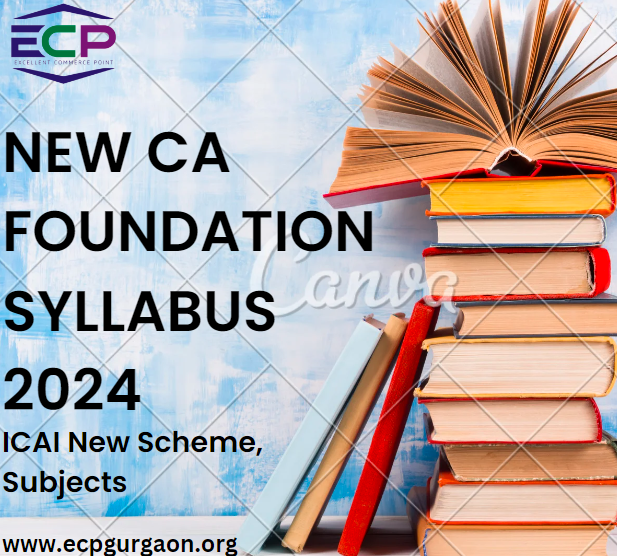New CA Foundation Syllabus 2024: ICAI New Scheme, Subjects
The Institute of Chartered Accountants of India (ICAI) has introduced a new syllabus for the CA Foundation course, applicable from 2024. The new scheme includes updated subjects and topics designed to provide aspiring chartered accountants with a comprehensive understanding of key concepts in accounting, finance, taxation, and business laws. This article serves as a guide to the new CA Foundation syllabus, highlighting the changes and key subjects covered under the revised scheme.
About CA Foundation: CLICK HERE
CA Foundation New Syllabus Papers 2024
In the new syllabus of CA Foundation 2024, under the new ICAI scheme, the following papers have been included:
Sl. No |
Paper Name |
Marks |
Type of Questions |
|---|---|---|---|
| 1 | Accounting | 100 | Subjective |
| 2 | Business Laws | 100 | Subjective |
| 3 | Quantitative Aptitude: | ||
| – Part A: Business Mathematics | 40 | Objective | |
| – Part B: Logical Reasoning | 20 | Objective | |
| – Part C: Statistics | 40 | Objective | |
| 4 | Business Economics | 100 | Objective |
Detailed CA Foundation June 2024 Syllabus – Under New Scheme
Below is a table containing the detailed ICAI CA Foundation new scheme syllabus for each of the papers mentioned above. The details also contain the important topics for each of the CA Foundation subjects.
Paper 1 – Accounting
Objective: To develop an understanding of the basic concepts and principles of accounting and apply the same in preparing financial statements and simple problem-solving.
Topics |
Sub Topics |
|---|---|
Theoretical Framework |
|
Accounting Process |
|
Inventories |
– Meaning, basis, and technique of inventory valuation, cost of inventory, net realizable value, and record system. |
Depreciation and Amortisation |
– Tangible and intangible assets- meaning & difference, concepts, methods of computation, and accounting treatment of depreciation/amortization, change in depreciation method. |
Bills of Exchange and Promissory Notes |
– Meaning of bills of exchange and promissory notes and their accounting treatment; accommodation bills. |
Preparation of Final accounts |
– Elements of financial statements, closing adjustment entries, trading account, profit and loss account, and balance sheet of manufacturing and non- manufacturing entities. |
Financial Statements of Not-for-Profit Org. |
– Significance and preparation of receipt and payment account, income and expenditure account, and balance sheet, difference between profit and loss account and income and expenditure account. |
Accounts from Incomplete Records |
– Excluding preparation of accounts based on ratios. |
Partnership And LLP Accounts |
|
Company Accounts |
|
Paper 2: Business Laws
Objective: To develop general legal knowledge of the law of Contracts, Sales and understanding of various forms of businesses and their functioning to regulate business environment and to acquire the ability to address basic application-oriented issues.
Topics |
Sub Topics |
|---|---|
Indian Regulatory Framework |
Major Regulatory Bodies such as the Ministry of Finance, Ministry of Corporate Affairs, SEBI, RBI, IBBI, Ministry of Law and Justice, etc. |
The Indian Contract Act, 1872 |
|
The Sale of Goods Act, 1930 |
|
The Indian Partnership Act, 1932 |
|
The Limited Liability Partnership Act, 2008 |
|
The Companies Act, 2013 |
|
The Negotiable Instruments Act, 1881 |
|
For Face to Face CA Coaching Classes: CLICK HERE
Paper 3: Quantitative Aptitude
Objective:
- To develop an understanding of the basic mathematical and statistical tools and apply the same in business, finance, and economic situations.
- To develop logical reasoning skills.
Topics and Subtopics
Part A: Business Mathematics |
Subtopics |
|---|---|
Ratio and proportion |
Ratio and proportion and Time and work-related problems, Laws of Indices, Exponents and Logarithms and AntiLogarithms |
Equations |
Linear Equations Upto Three Variables, Quadratic and Cubic equations in one variable. Applications in Business Related Problems. |
Linear Inequalities |
Linear Inequalities in one and two variables and the solution space |
Mathematics of Finance |
Simple Interest, Compound Interest, Nominal and Effective Rate of Interest, Present Value, Net Present Value, Future Value, Perpetuity, Annuities, Sinking Funds, Calculating EMI, Calculations of Returns: Nominal and Effective rate of Return, Compound Annual Growth Rate(CAGR) |
Permutations and Combinations |
Basic concepts of Permutations and combinations: Introduction, the factorial, permutations, results, circular permutations, permutations with restrictions, Combinations With standard results |
Sequence and Series |
Introduction Sequences, Series, Arithmetic and Geometric progression, Relationship between AM and GM and Sum of n terms of special series and Business Applications |
Sets, Relations, and Functions |
Basics of Limits and Continuity Functions |
Part B: Logical Reasoning |
Subtopics |
|---|---|
| Number series | Coding and Decoding and odd man out, Direction Tests, Seating Arrangements, Blood Relations |
Part C: Statistics |
Subtopics |
|---|---|
Statistical Representation of Data |
Diagrammatic representation of data, Frequency Distribution, Graphical representation of Frequency Distribution–Histogram, Frequency Polygon, Ogive, Pie-chart |
| Basic principles of sampling theory, comparison between sample survey and complete enumeration, some important terms associated sampling type of sampling, sampling and non-sampling errors | |
Measures of Central tendency and Dispersion |
Mean Median, Mode, Mean Deviation, Quartiles and Quartile Deviation, Standard Deviation, Coefficient of Variation, Coefficient of Quartile Deviation |
Probability |
Independent and dependent events; mutually exclusive events. Total and Compound Probability and Bayes Theorem |
Theoretical Distributions |
Random variables, Discrete and Continuous Random variables, Expectation of a discrete random variable, Theoretical Distributions: Binomial Distribution, Poisson distribution–basic application and Normal Distribution–basic applications |
Correlation and Regression |
Scatter diagram, Karl Pearson’s Coefficient of Correlation Rank Correlation, Regression lines, Regression equations, Regression coefficients |
Index Numbers |
Uses of Index Numbers, Problems involved in construction Index Numbers, Methods of construction of Index Numbers.BSE SENSEX NSE |
Paper 4: Business Economics
Objective: To develop an understanding of the concepts and theories of Economics and to acquire the ability for addressing application-oriented issues.
Topics and Subtopics
| Topic | Subtopics |
|---|---|
| Introduction to Business Economics | – Meaning and scope of Business Economics. |
| Basic Problems of an Economy and Role of Price Mechanism | – Theory of Demand and Supply |
| – Theory of Consumer’s Behaviour – Indifference Curve approach. | |
| – Theory of Production and Cost | |
| Price Determination in Different Markets | – Market Structures: Perfect Competition, Monopoly and Monopolistic Competition. |
| – Price Determination in these Markets. | |
| – Price-Output Determination under different Market Forms. | |
| Determination of National Income | – Macro Economic Aggregates and Measurement of National Income. |
| – Determination of National Income: Keynes’ Two Sector Basic Model, Three Sectors and Four Sectors Models. | |
| Business Cycles | – Meaning, Phases, Features, Causes behind these Cycles. |
| Public Finance | – Fiscal functions: An Overview, Centre and State Finance. |
| – Market Failure/Government Intervention To Correct Market Failure. | |
| – Process of budget making: Sources of Revenue, Expenditure Management, and management of Public Debt. | |
| Monetary Economics | – Money Market |
| – Monetary Policy | |
| International Trade | – Theories of International Trade including theories of intra-industry trade Krugman. |
| – Trade Policy–The Instruments of Trade Policy. | |
| – Trade Negotiations. | |
| – Exchange Rates and its economic effects. | |
| – International Capital Movements: Foreign Direct Investment. | |
| Indian Economy | – Before 1950 – Chanakya and Nand Vansh |
| – OECD Paper (1950-1991) | |
| – Basic knowledge 1991 Onwards |
The new syllabus for CA Foundation provides a comprehensive understanding of various economic concepts and their applications in business and the global economy.
Requirements for Clearing CA Foundation Examination 2024
To pass the CA Foundation examination in 2024, a candidate must meet the following criteria:
- Obtain a minimum of 40% marks in each paper.
- Obtain a minimum of 50% marks in the aggregate of all papers.
Paper Format:
- Papers 1 and 2 are objective-type papers and will have negative marking (details to be notified later).
- Papers 3 and 4 are subjective type papers.
For CA Foundation September 2024 Coaching Classes: CLICK HERE
Overview of CA Foundation Exam
The CA Foundation exam serves as the entry-level examination for individuals aspiring to pursue a career in Chartered Accountancy. It is conducted by the Institute of Chartered Accountants of India (ICAI), the governing body responsible for regulating the CA profession in the country. The exam assesses candidates on their knowledge and understanding of fundamental accounting principles, business laws, economics, and quantitative aptitude.
Purpose:
The primary objective of the CA Foundation exam is to ensure that candidates possess the necessary skills and knowledge required to pursue the CA course further. It serves as a gateway for students to enter the prestigious Chartered Accountancy profession.
Structure:
The CA Foundation exam consists of four papers, divided into two groups:
- Paper 1: Principles and Practices of Accounting
- Paper 2: Business Laws and Business Correspondence and Reporting
- Paper 3: Business Mathematics, Logical Reasoning, and Statistics
- Paper 4: Business Economics and Business and Commercial Knowledge
Eligibility:
To appear for the CA Foundation exam, candidates must have completed their 10+2 examination from a recognized board or institution. Additionally, they need to register with the ICAI for the CA Foundation course at least four months before the examination.
Examination Pattern:
- Papers 1 and 2 are subjective papers, while Papers 3 and 4 are objective-type papers.
- Each paper carries a maximum of 100 marks, with a total of 400 marks for all four papers combined.
- To pass the exam, candidates must score a minimum of 40% marks in each paper and a minimum of 50% marks in aggregate across all papers.
Preparation Tips for CA Foundation Syllabus 2024
Here are some useful tips to help you prepare for the CA Foundation exam:
- Know the Syllabus: Understand the CA Foundation syllabus thoroughly. Pay attention to the topics included and excluded from the curriculum and prepare accordingly.
- Start Early: Begin your preparations early to allow enough time for revision and practice. Starting early can help you cover the syllabus more effectively.
- Refer to the Right Study Material: Utilize the study material provided by ICAI for the CA Foundation exam. Additionally, refer to other recommended books and resources to enhance your understanding of the topics.
- Practice with Mock Tests: Take advantage of mock tests to simulate the exam environment and improve your performance. ICAI provides mock tests on its website, which can be a valuable resource for practice.
For CA Foundation Online Coaching: CLICK HERE
Conclusion
New CA Foundation syllabus for 2024 introduces updated subjects and topics designed to provide aspiring chartered accountants with a comprehensive understanding of key concepts in accounting, finance, taxation, and business laws. The exam structure includes four papers covering various aspects of accounting, business laws, quantitative aptitude, logical reasoning, statistics, and economics. To pass the exam, candidates must meet specific criteria, including obtaining a minimum of 40% marks in each paper and 50% marks in the aggregate. Preparation tips include understanding the syllabus, starting early, referring to the right study material, and practicing with mock tests. Overall, the CA Foundation exam serves as a crucial step towards a rewarding career in Chartered Accountancy, requiring diligence, dedication, and a strong understanding of the core concepts.
For CA/CMA/CS Coaching: ENROLL NOW
FOR MORE DETAILS, CONTACT US :-
9534443950 , 7827675575
GMAIL :-
FACEBOOK :-
https://www.facebook.com/excellentcommerce.point.1/
INSTAGRAM :-
https://www.instagram.com/excellent_commerce_point/
LINKEDIN :-
https://www.linkedin.com/in/excellent-commerce-point-004680236/
TWITTER :-



